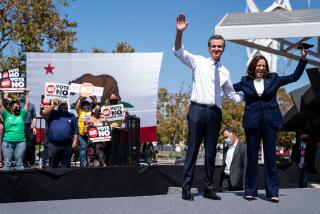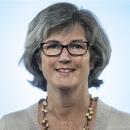No. 1 Job Steals the Spotlight
- Share via
It is the first California election of the century, a door opening to the future. And it certainly represents a break from the past: The presidential contests for both major parties are alive, to one degree or another. Many adult Californians, for the first time in their lives, will be voting in a presidential primary that matters.
For months, Democrats Al Gore and Bill Bradley, and Republicans George W. Bush, John McCain and Alan Keyes, have crossed the state, searching for votes. In two days, their fates will be decided.
The state’s blanket primary, which allows voters to cast their ballots for candidates of any party, set up two contests in one: a battle for popularity, in which crossover voters are the coin of the realm, and the war for delegates, where all that matters is how many members of his own party a candidate can attract.
All eyes--at least those watching early--were on the presidential contest. Officials from both major political parties, unaccustomed to primaries that matter, were out-crowing one another at the possibilities for their own advancement. The secretary of state’s office, which each election cycle is called upon to parse why Californians don’t vote, crossed its fingers and hoped for a big turnout.
“P.T. Barnum said it best,” noted Bob Mulholland, the eminence grise of the state Democratic Party. “If you want to build a crowd, start a fight.”
The U.S. Senate race was quiet because of the high profile of the presidential race and because it served the interests of the two favored candidates. Democratic incumbent Dianne Feinstein and Republican Tom Campbell were husbanding their resources for the fall. It was in neither’s interest to stir the waters--Feinstein sailed above it all on a tide of burgeoning support from Californians, and Campbell avoided giving his GOP opponents a chance to rise beyond single digits in the polls.
Those opponents, state Sen. Ray Haynes (R-Riverside) and San Diego County Supervisor Bill Horn, spent the campaign trying to raise enough money to hike their profiles, but neither did so.
Of the 52 congressional seats up for grabs, only a few appeared competitive, the advantages of incumbency trumping challengers’ efforts in most of the others. At the state level, the 80 members of the Assembly and one-third of the 40-member Senate awaited the voters’ judgment.
As is typical in California, much of political donors’ largess was being lavished on ballot measures. Television sets and radios sparked with warring ads; as they were with the Indian gambling initiative, Proposition 5, in 1998, the Native American tribes were most prominent on television as they sought to push through its ideological heir, Proposition 1A.
Proposition 22, which would ban gay marriages, carried emotional freight with it, but not the political sway of some initiative campaigns of years past.
Regardless of how the election turns out, however, it will be instructive for what it says about the fault lines that will define California for the new century. Two major forces--the rise of Latino voters and the increasing moderation of the state--are moving like tectonic plates, growing ever more forceful.
An indicator of the future of the state’s largely white electorate came in last week’s Los Angeles Times poll. Fully 15% of Latino voters said they would cast ballots Tuesday for the first time, a reflection of the maturation of a group whose voting strength is steadily creeping closer to its demographic heft. Only 2% of whites and 3% of African Americans were to be first-time voters.
The state’s moderate cast was confirmed by new voter registration numbers. Those declaring that they “decline to state” party preferences--in common terms, those put off by the ideological poles--grew to 2.1 million last month, up from 1.6 million in 1996. In the last month before the close of registration on Feb. 7, more than 77,000 of those moderates registered, almost five times the increase seen by state Republicans. Democrats did worse, losing more than 91,000 voters, although they continue to be the largest political party in California.
More notably, the proportion of voters voluntarily heading for the center is rising. Over the years, while the percentages of liberals and conservatives have grown, internal shifts have redefined those terms, at least in California. More and more, liberals are calling themselves “somewhat” liberal, just as conservatives are calling themselves “somewhat” conservative.
Taken together, two-thirds of California voters now reside on the narrow band that runs from fairly conservative to moderate to fairly liberal--a venue that leaves them up for grabs much of the time.
(BEGIN TEXT OF INFOBOX / INFOGRAPHIC)
The Race for the White House
The Major Candidates, the Key Issues
Viewpoints *
Where the major Democratic and Republican presidential candidates stand on various issues.
THE DEMOCRATS
Bill Bradley
* Age 56
* Residence Montclair, N.J.
* Education History degree from Princeton University, 1965. Rhodes Scholar at Oxford University, 1966-67.
* Career highlights Professional basketball player, 1967-77. U.S. senator from New Jersey, 1978-96. Author, lecturer, 1996 to present.
* Family Married to Ernestine Schlant. One daughter, one stepdaughter.
Al Gore
* Age 51
* Residence Washington, D.C.
* Education Government degree, Harvard University, 1969. Attended Vanderbilt Divinity School, 1971-72. Attended Vanderbilt law school, 1976.
* Career highlights U.S. Army, 1969-71. Newspaper reporter, 1973-76. U.S. representative from Tennessee, 1977-85. U.S. senator from Tennessee, 1985-93. Vice president, 1993 to present.
* Family Married to former Mary Elizabeth “Tipper” Aitcheson. Three daughters, one son.
THE REPUBLICANS
George W. Bush
* Age 53
* Residence Austin, Texas
* Education History degree from Yale University, 1968. MBA, Harvard University, 1975.
* Career highlights Businessman in various industries, primarily oil, 1968 to 1989. Managing partner of Texas Rangers baseball team, 1989 to 1994. Texas governor, 1995 to present.
* Family Married 22 years to former Laura Welch. Twin daughters.
Alan Keyes
* Age 49
* Residence Gaithersburg, Md.
* Education Government degree, 1972, and doctorate in government, 1979, Harvard University.
* Career highlights State Department staffer, 1978-83. U.S. ambassador to the United Nations Economic and Social Council, 1983-85. Assistant secretary of state for international organization affairs, 1985-87. Scholar, interim president Alabama A&M; University, radio host.
* Family Married to Jocelyn Marcel since 1981; three children.
John McCain
* Age 63
* Residence Phoenix and Washington
* Education Naval Academy, 1958. Naval War College, 1973-74.
* Career highlights U.S. Navy, 1958-81. U.S. representative from Arizona, 1983-86. U.S. senator from Arizona, 1987 to present.
* Family Married since 1980 to former Cindy Hensley; seven children, three of them from first marriage
More to Read
Get the L.A. Times Politics newsletter
Deeply reported insights into legislation, politics and policy from Sacramento, Washington and beyond. In your inbox twice per week.
You may occasionally receive promotional content from the Los Angeles Times.











